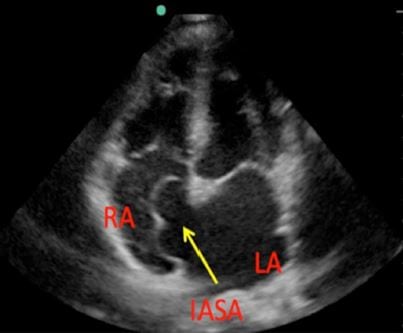| Author | Affiliation |
|---|---|
| Michael Butterfield, MD, MS, MPH | Tulane University Medical Center, Internal Medicine, New Orleans, Louisiana |
| Christine Riguzzi, MD | Highland General Hospital, Department of Emergency Medicine, Oakland, California |
| Oron Frenkel, MD, MS | Highland General Hospital, Department of Emergency Medicine, Oakland, California |
| Arun Nagdev, MD | Highland General Hospital, Department of Emergency Medicine, Oakland, California |
ABSTRACT
A 61 year-old man presented to the Emergency Department for one day of nonspecific chest pain. Bedside echocardiogram performed by the emergency physician revealed normal systolic cardiac function but also showed a large ( > 10mm) bicornuate interatrial septal aneurysm (IASA) projecting into the right atrium (Figure 1, Video 1). There was no evidence of intraatrial thrombus. A formal echocardiogram performed later that day confirmed the diagnosis and also detected a patent foramen ovale (PFO) with a left-to-right shunt that reversed with Valsalva maneuver.
DISCUSSION
Given the increasing use of point-of-care echocardiography in the emergency department, clinicians should learn to recognize common cardiac malformations such as IASA, a congenital lesion with a prevalence between 2–10%.1 While familiar to cardiologists, the presence of an IASA may surprise the emergency physician, as few if any case reports have appeared in the emergency medicine literature. The basic differential diagnosis to consider for IASA should include thrombus, intracardiac tumor, and Chiari network (a web-like embryonic remnant in the right atrium).2
Though usually benign, IASAs have been associated with cryptogenic stroke in younger patients (< 55 years).3,4 They are thought to facilitate thrombus formation via stasis and provocation of atrial arrhythmias. IASAs are also highly associated with PFO, and the combination of the two lesions may increase stroke risk in a synergistic fashion.5,6 Anticoagulation is typically initiated as secondary prevention in patients with a history of stroke or as primary prophylaxis in patients with a visualized atrial thrombus.7–9
Figures

Figure
Four-chamber apical view demonstrating a large interatrial septal aneurysm.
RA, right atrium; IASA, interatrial septal aneurysm; LA, left atrium
Footnotes
Full text available through open access at http://escholarship.org/uc/uciem_westjem
Address for Correspondence: Michael Butterfield, MD MS MPH, Tulane University Health Sciences Center, 1430 Tulane Avenue, SL-50, New Orleans, LA, 70112. Email: mbutterf@tulane.edu 9 / 2014; 15:719 – 720
Submission history: Revision received June 30, 2014; Accepted July 7, 2014
Conflicts of Interest: By the WestJEM article submission agreement, all authors are required to disclose all affiliations, funding sources and financial or management relationships that could be perceived as potential sources of bias. The authors disclosed none.
REFERENCES
1 Tzimas P, Papadopoulos G Huge interatrial septal aneurysm: a coincidental but rather fatal finding. Case Rep Med. 2011; :1-3
2 Wysham DG, McPherson DD, Kerber RE Asymptomatic aneurysm of the interatrial septum. J Am Coll Cardiol. 1984; 4:1311-1314
3 Cabanes L, Mas JL, Cohen A Atrial septal aneurysm and patent foramen ovale as risk factors for cryptogenic stroke in patients less than 55 years of age. A study using transesophageal echocardiography. Stroke J Cereb Circ. 1993; 24:1865-1873
4 Razaq M, Parihar RK, Saini G Atrial septal aneurysm and stroke. Ann Pediatr Cardiol. 2012; 5:98-99
5 Wahl A, Krumsdorf U, Meier B Transcatheter treatment of atrial septal aneurysm associated with patent foramen ovale for prevention of recurrent paradoxical embolism in high-risk patients. J Am Coll Cardiol. 2005; 45:377-380
6 Carcano C, Kirsch J “Hidden Danger” a case report on interatrial septal aneurysm. Int J Cardiovasc Imaging. 2012; 28:1545-1546
7 Mas JL, Arquizan C, Lamy C Recurrent Cerebrovascular Events Associated with Patent Foramen Ovale, Atrial Septal Aneurysm, or Both. N Engl J Med. 2001; 345:1740-1746
8 Pratap P, Foster MM, Labovitz AJ Spontaneous echo contrast at a large inter-atrial septal aneurysm. Echocardiography. 2013; 30:E296-297
9 Aryal MR, Pradhan R, Pandit AA A “teapot” atrial septal aneurysm with spontaneous thrombus in an asymptomatic patient. Circulation. 2013; 128:e409-410


